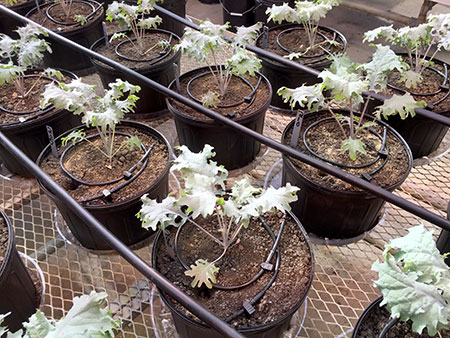Air-propelled abrasive weed control, also called “weed blasting”, is the application of existing sand-blasting technology (typically used for industrial cleaning or etching applications) to physically abrade leaf, stem, and meristematic tissue of weed seedlings growing within crop rows. This novel weed management tactic was first tested in organic corn and soybean cropping systems of the Midwest U.S., but we are now exploring its expanded use in high-value organic vegetable crops. Early studies on weed blasting used granulated corn cobs and walnut shells as abrasive grits, but we are researching the possibility of using organic granular fertilizers (e.g., soybean meal) to integrate nitrogen and weed management and reduce the environmental and economic cost of grit application. In this multi-state, multi-institution project, we are measuring vegetable crop growth and yield, disease incidence, weed suppression, and soil nitrogen mineralization in response to different abrasive grits and application rates.
Research Updates

Combining mulch films with abrasive weeding increases yield and profitability of organic pepper production. Download PDF.
Funding Sources
- USDA NIFA Organic Research and Education Initiative (award # 2014-51300-22233).
Collaborators
- University of Illinois at Urbana – Champaign, South Dakota State University, USDA-ARS Soil Management Research (Morris, MN), and eOrganic (Oregon State University)
Related Publications
- Luong, T.K.N., F. Forcella, S.A. Clay, M. Douglass, and S.E. Wortman. 2020. Abrasive weeding as a vehicle for precision fertilizer management in organic vegetable production. HortTechnology. https://doi.org/10.21273/HORTTECH04714-20
- Carlson, M., F. Forcella, S.E. Wortman, D. Clay, and S.A. Clay. 2020. Organic fertilizer abrasive grits increase soil available nitrogen and plant height and biomass. Agrosystems, Geosciences, and Environment. DOI:10.1002/agg2.20091
- Braun, E.A., S.T. Lovell, M. Babadoost, F. Forcella, S. Clay, D. Humburg, and S.E. Wortman. 2019. Abrasive Grit Application in Organic Red Pepper: An Opportunity for Integrating Nitrogen and Weed Management. HortScience 54:1509-1516. https://doi.org/10.21273/HORTSCI14162-19
- Wortman, S. E., F. Forcella, D. Lambe, S. A. Clay, and D. Humburg. 2018. Profitability of abrasive weeding in organic grain and vegetable crops. Renewable Agriculture and Food Systems FirstView: https://doi.org/10.1017/S1742170518000479
- Forcella, F., D. Humburg, S. E. Wortman, and S. A. Clay. 2018. Potential of abrasive grit to damage quackgrass. Canadian Journal of Plant Science 98:963-966.
- Wortman, S. E., F. Forcella, S. Clay, and D. Humburg. 2017. Abrasive-weeding: A new tool for weed management in organic agriculture. eOrganic Fact Sheet. https://eorganic.org/node/23223
- Wortman, S. E. 2015. Air-propelled abrasive grits reduce weed abundance and increase yields in organic vegetable production. Crop Protection 77:157-162.
- Wortman, S. E. 2014. Integrating weed and vegetable crop management with multifunctional air-propelled abrasive grits. Weed Technology 28:243-252.


